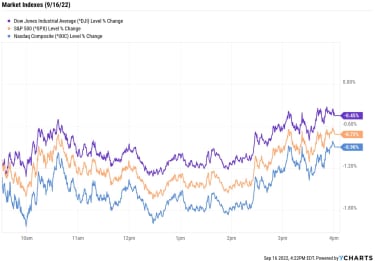Stock Market Today
The delivery giant said its fiscal Q1 results will come in lower than expected and withdrew its full-year guidance as demand slows.Stocks capped off a terrible week with another slide as a warning from one of Wall Street’s bellwether firm’s stoked concern about the U.S. economy.
After Thursday’s close, delivery giant FedEx (FDX, -21.4%) – whose financial results are often seen as a read on broader economic conditions – issued preliminary fiscal first-quarter earnings and revenue figures that were well below estimates. The company cited a recent acceleration in “global volume softness,” and specifically pointed to “macroeconomic weakness in Asia and service challenges in Europe.” FDX also withdrew its outlook for the full fiscal year, and said it is initiating several cost-cutting measures to offset the effects of lowered demand, including deferring staff hiring, closing 90 FedEx office locations and ending Sunday operations for several FedEx Ground locations. The company is slated on the earnings calendar to report its full quarterly results after next Thursday’s close.
Wall Street’s nerves were already frayed ahead of FedEx’s financial warning, as this week’s red-hot inflation reading all but assured another large rate hike from the Federal Reserve at next week’s meeting. But an additional contributing factor to this week’s massive volatility is likely today’s quadruple-witching options expiration, which is when index futures, index options, stock options and individual-stock futures all expire at once. This happens four times a year – on the third Friday in March, June, September and December – and sometimes leads to heavy volume and erratic moves in parts or all of the market.
Sign up for Kiplinger’s FREE Investing Weekly e-letter for stock, ETF and mutual fund recommendations, and other investing advice.
At the close, the Nasdaq Composite was down 0.9% at 11,448, the S&P 500 Index was off 0.7% at 3,873, and the Dow Jones Industrial Average was 0.5% lower at 30,822. All three indexes suffered significant weekly losses.
YCharts
Other news in the stock market today:
The small-cap Russell 2000 fell 1.5% to 1,798.U.S. crude futures eked out a modest gain to end at $85.11 per barrel.Gold futures rose 0.4% to finish at $1,683.50 an ounce.Bitcoin slipped 0.9% to $19,629.81. (Bitcoin trades 24 hours a day; prices reported here are as of 4 p.m.) International Paper (IP, -11.2%) and Packaging Corporation of America (PKG, -11.0%) plunged after Jefferies analyst Philip Ng downgraded the packaging stocks to Underperform, the equivalent of Sell. The downgrade reflects “the massive inventory glut in containerboard, with our checks indicating orders decelerating sharply & broad based downtime taken even by the smaller players,” Ng writes in a note. “Our contacts believe a fourth-quarter price cut is imminent, and considering the 5%-6% of new capacity slated to come online the next 12 months have yet to impact the mkt, conditions could worsen in 2023.”Growth stocks were some of the biggest decliners today, with Meta Platforms (META, -2.2%), Twilio (TWLO, -4.8%) and Snowflake (SNOW, -6.1%) seeing big declines.Why Low-Volatility Funds Could Be a Good StrategyDon’t be discouraged. Yes, it’s a difficult time for the stock market – and there’s likely more volatility to come. But investing is a marathon, not a sprint, and there are ways to ride out the storm. Most recently, we’ve mentioned the use of quality income-paying stocks, like the Dividend Kings or Dividend Aristocrats, all of which have decades of consistent dividend growth under their belts.
But given this week’s panic-selling, it seems like an opportune time to revisit low-volatility strategies. “Minimum volatility is a defensive bet,” says Huw Roberts, head of analytics at data research firm Quant Insight. “The whole aim is to keep people invested in the market, but targets stocks that aren’t as volatile or don’t always behave in the same way as the overall index (say the S&P 500).” Huw adds that for those “worried about inflation, Fed rate hikes etc.,” taking this route might be a good strategy. Here, we’ve compiled 10 low-volatility funds that could give investors peace of mind over the long run. Check them out.
